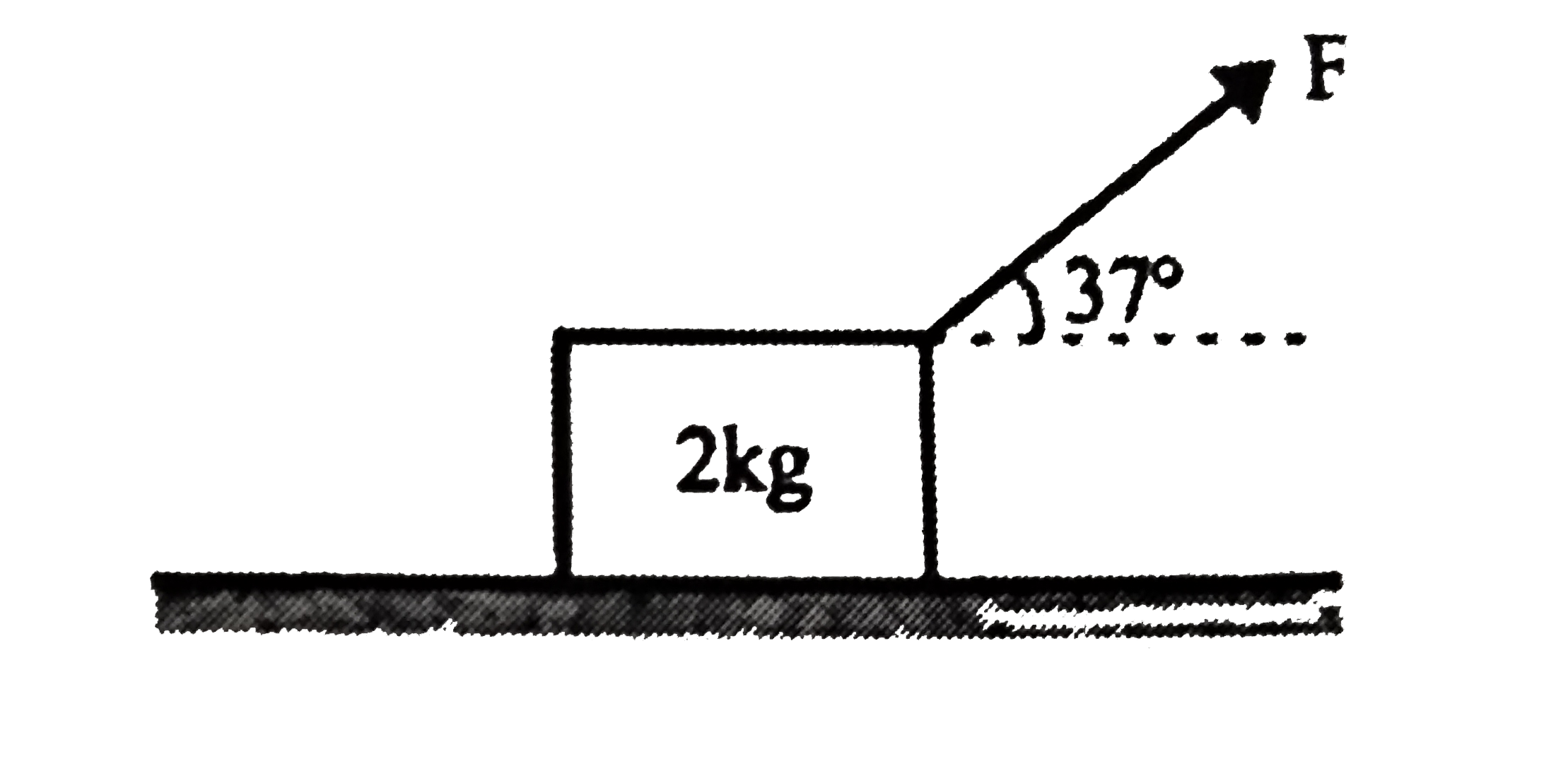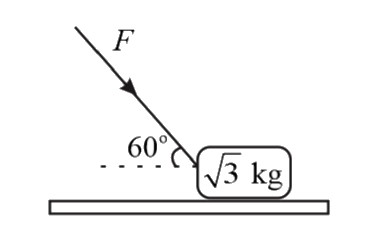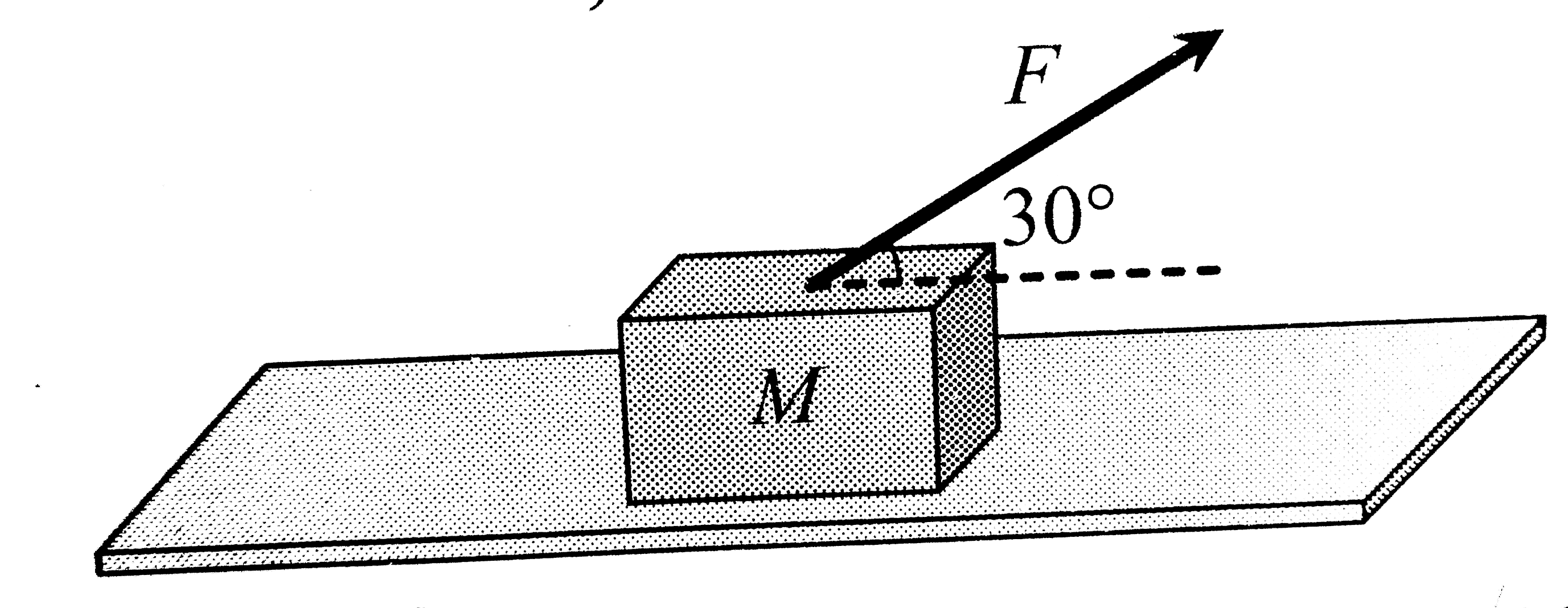A force F is acting at an angle θ with horizontal on a block of mass 12 kg placed on a rough 3 horizontal surface having coefficient of friction μ=34 as shown in the figure. The minimum value of force F to just move the block will be (g=10ms−2)
36N
96N
72N
54N
To find the minimum value of the force F required to just move the block, we will follow these steps:
Step 1: Identify the forces acting on the block
The forces acting on the block are:
- The weight of the block W=mg acting downwards.
- The normal force N acting upwards.
- The applied force F at an angle θ with the horizontal, which can be resolved into two components:
- Horizontal component: Fcosθ
- Vertical component: Fsinθ
Step 2: Write the equations for vertical forces
In the vertical direction, the forces must balance:
N+Fsinθ=mg
From this, we can express the normal force N:
N=mg−Fsinθ
Step 3: Write the equation for friction
The frictional force f opposing the motion is given by:
f=μN
Substituting for N:
f=μ(mg−Fsinθ)
Step 4: Write the equation for horizontal forces
In the horizontal direction, the frictional force must equal the horizontal component of the applied force for the block to just start moving:
f=Fcosθ
Substituting for f:
Fcosθ=μ(mg−Fsinθ)
Step 5: Rearranging the equation
Rearranging the equation gives:
Fcosθ+μFsinθ=μmg
Factoring out F:
F(cosθ+μsinθ)=μmg
Thus, we can express F:
F=μmgcosθ+μsinθ
Step 6: Substitute values
Given:
- m=12kg
- g=10m/s2
- μ=34
Substituting these values into the equation:
F=(34)(12)(10)cosθ+(34)sinθ
F=90cosθ+34sinθ
Step 7: Find the maximum value of F
To find the minimum value of F, we need to maximize the denominator cosθ+34sinθ. The maximum value occurs when:
√1+(34)2=√1+916=√2516=54
Thus, the maximum value of F is:
Fmin=9054=90×45=72N
Final Answer
The minimum value of the force F required to just move the block is 72N.
---
The forces acting on the block are:
- The weight of the block W=mg acting downwards.
- The normal force N acting upwards.
- The applied force F at an angle θ with the horizontal, which can be resolved into two components:
- Horizontal component: Fcosθ
- Vertical component: Fsinθ
In the vertical direction, the forces must balance:
N+Fsinθ=mg
From this, we can express the normal force N:
N=mg−Fsinθ
The frictional force f opposing the motion is given by:
f=μN
Substituting for N:
f=μ(mg−Fsinθ)
In the horizontal direction, the frictional force must equal the horizontal component of the applied force for the block to just start moving:
f=Fcosθ
Substituting for f:
Fcosθ=μ(mg−Fsinθ)
Rearranging the equation gives:
Fcosθ+μFsinθ=μmg
Factoring out F:
F(cosθ+μsinθ)=μmg
Thus, we can express F:
F=μmgcosθ+μsinθ
Given:
- m=12kg
- g=10m/s2
- μ=34
F=(34)(12)(10)cosθ+(34)sinθ
F=90cosθ+34sinθ
To find the minimum value of F, we need to maximize the denominator cosθ+34sinθ. The maximum value occurs when:
√1+(34)2=√1+916=√2516=54
Thus, the maximum value of F is:
Fmin=9054=90×45=72N
The minimum value of the force F required to just move the block is 72N.
Similar Questions
A force F is acting at an angle θ with horizontal on a block of mass 12 kg placed on a rough horizontal surface having coefficient of friction μ=34 as shown in the figure. The minimum value of force F to just move the block will be (g=10ms−2)
View SolutionA block of mass 10kg is placed on a rough horizontal surface having coefficient of friction μ=0.5 . If a horizontal force of 100N is acting on it, then acceleration of the block will be.
View Solution
Knowledge Check
A block of mass 10kg is placed on a rough horizontal surface having coefficient of friction μ=0.5 . If a horizontal force of 100N is acting on it, then acceleration of the block will be.
A10ms−2B5ms−2C15ms−2D0.5ms−2
A block of mass 10kg is placed on a rough horizontal surface having coefficient of friction μ=0.5 . If a horizontal force of 100N is acting on it, then acceleration of the will be.
View SolutionA block of mass 10kg is placed on a rough horizontal surface having coefficient of friction μ=0.5 . If a horizontal force of 100N is acting on it, then acceleration of the will be.
View SolutionA block of mass 2 kg is kept on a rough horizontal floor an pulled with a force F. If the coefficient of friction is 0.5. then the minimum force required to move the block is :-

View SolutionA force of 49 N just able to move a block of wood weighing 10 kg on a rough horizontal surface , then coefficient of friction is
View SolutionA force F is applied on a block of mass √3kg which rests on a horizontal surface with a coefficient of friction 12√3. The maximum value of F for which the block doesn't move, is [Take g=10ms−2]

View SolutionA block of mass m=5kg is resting on a rough horizontal surface for which the coefficient of friction is 0.2 . When a force F=40N is applied, the acceleration of the block will be (g=10m/s2) .

View SolutionA force of 10N is acting on a block of 20kg on horizontal surface with coefficient of friction μ=0.2. Calculate the work done by the force.
View Solution